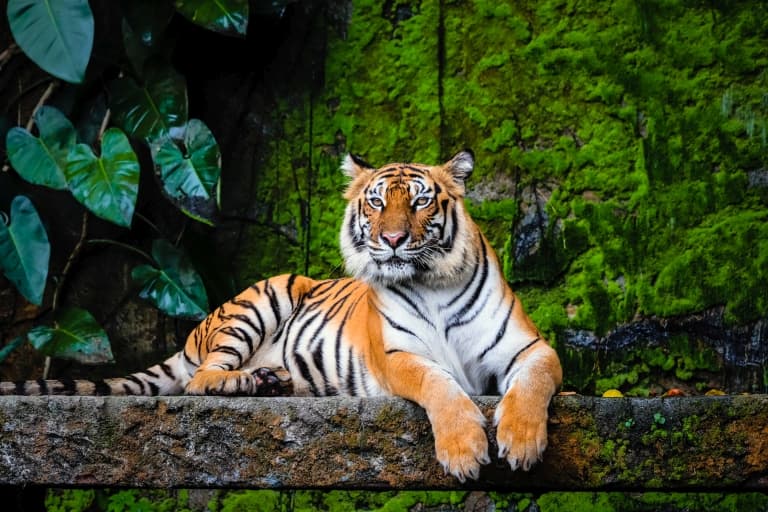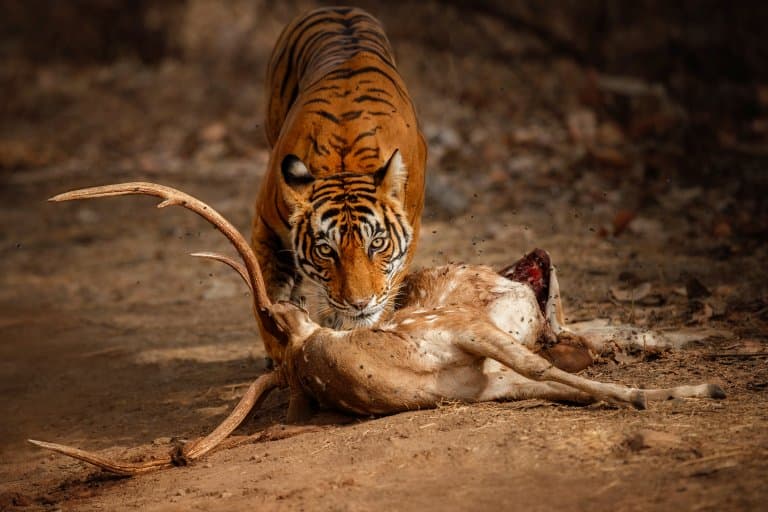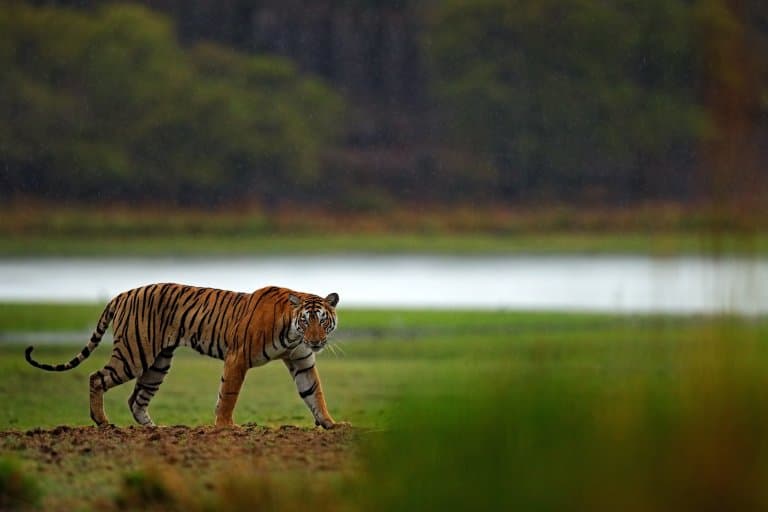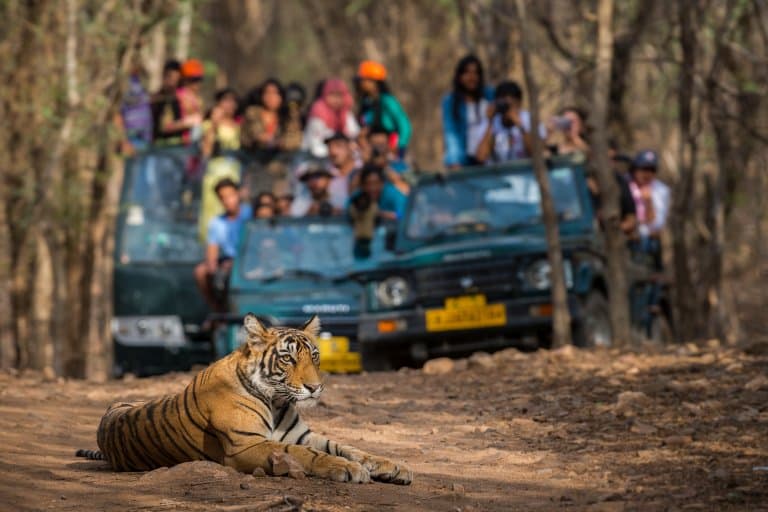Bengal Tiger Profile
There’s nothing that reminds us of our tree-dwelling ancestry and strikes fear into the monkey brain quite like a man-eating jungle monster. And of these, there’s nothing larger and more horrifyingly charismatic than the tiger.
The stripes of a Bengal tiger reflect a contradictory existence as both the most revered and persecuted of the big cats, with a long and complex history of human interaction.
Bengal tigers are a population of a subspecies of Panthera tigris (tiger), once prevalent in Asia, since reduced to a fraction of their former glory. They are known for their beautiful orange coats with distinctive black stripes.

Bengal Tiger Facts Overview
| Habitat: | Diverse, from alluvial to forest and mangrove |
| Location: | India, Bangladesh, Nepal, Bhutan, and southwestern China |
| Lifespan: | Up to 25 years in captivity, 15 in the wild |
| Size: | 10m (3.3ft) long |
| Weight: | Up to 260kg |
| Colour: | Golden brown/yellow with black stripes |
| Diet: | Pigs, deer, buffalo; mid-to-large herbivores, but also smaller animals |
| Predators: | Humans |
| Top Speed: | Possibly up to 60km/h (37mph) |
| No. of Species: | 1 |
| Conservation Status: | Endangered (IUCN) |
Bengal tigers inhabit tropical forests, mangroves and grasslands in India, Bangladesh, Nepal, Bhutan, and southwestern China.
These incredible cats are large, powerful athletes, capable of great feats of grace and brutality.
Their very presence affects the landscape of their ecosystem, but their power has drawn the attention of people whose fear and greed have decimated their number.
Still, last-ditch attempts to save the species do appear to be turning the tide, but the future is still far from certain for this charismatic feline.
Interesting Bengal Tiger Facts
1. All-terrain cats
Many populations of tigers are so comfortable around water that they’re considered semi-aquatic. They’re one of the few cats that don’t fear getting wet, and will even comfortably consume food while submerged.
They can also climb trees, run through snow or sand, and hide miraculously in vivid green grass. These are exceptional predators, highly specialised for their solitary lives as hunters.
The incredible Bengal tiger made our top 10 apex predators in the world list. 1
2. They’re one of the largest carnivorans on land
Tigers are the largest cats on Earth, and the Bengal populations are some of the biggest. They’re immensely powerful and have agility to match.
They can grow over 2m in body length (excluding tail) and weight as much as 260kg. They are considered to be on average slightly smaller than the very largest subspecies, the Siberian tiger.
They can brute-force their way to a meal, bringing down huge animals like water buffalo, or chase down more nimble prey like deer. They’ve also been known to eat snakes, porcupines, and birds, among other smaller items.
They can eat anywhere from 40 to 88 pounds of meat when hunting.2

3. Bengal tigers have the largest teeth of all big cats
Bengal tigers canines can grow up to 10cm (3.9 inches) in length. This makes them the longest teeth amongst all big cat species.
Bengal tigers will ambush their prey from as close a distance as possible, often from behind or the side, and grasp their throat to kill it.
4. They’re significant ecosystem contributors
This large mass of mammal and its generalistic predation style means it has a significant impact on population control in its habitat.
Tigers are therefore keystone species that help hold the ecosystem in an intricate balance, and they’ve been doing so since the Pleistocene. As such, they’ve shared a lengthy and intertwined history with human development.

5. They’re an ancient human icon
At their peak, there were likely over 50,000 tigers on the Indian subcontinent.
An icon of grace, power, and primal terror, they are understandably represented throughout human historical records as a mascot for all of these characteristics.
Tigers were likely one of the Neolithic humans’ most potent muses, and their presence has followed us for thousands of years. But this perseverance has been threatened dramatically in recent times.
6. But they’re in serious trouble
Tigers aren’t the most social of animals and generally tend to keep to themselves. They have vast territories, which they protect from competition, meaning that their population densities are low.
The home range of a female and her cubs might be up to 31 km2, and while there was plenty of room for over 50k of these in their historical range, this has been shrinking rapidly.
Habitat loss is about the most pressing issue for wildlife in general and for a large mammal that requires a lot of space and a lot of food, this issue is compounded.
Diminishing habitats for Bengal tigers have reduced their range significantly, and in many areas, they’re now locally extinct. But it’s not just habitat loss that threatens them. 3
7. Even their penis is being poached
The human obsession with penises is a baffling one that is at least as old as the earliest forms of palaeolithic artwork.
In fact, the apparent evolutionary selection for disproportionately large male appendages compared with other primates suggests that it’s a fixation dating back well into our evolutionary history.
A preoccupation with what’s in our jeans appears to be in our genes, but sadly, it’s not only ours we’re fanatical about.
The idea that consuming tiger penis boosts male sexual function is yet another phenomenally reckless and stupid superstition that not only highlights our unhealthy attachments to erections but also demonstrates that we’re willing to eradicate an entire species if it’ll give us a good boner.
Needless to say, it’s not true. But the pervasive human condition of holding onto beliefs in the face of overwhelming evidence against them has led to an entire industry of tiger poaching.
And Chinese folklore shows no sign of updating its penis-oriented nutritional advice. 4

8. But it’s not all about the D
The Chinese rightfully get the blame for a litany of environmental atrocities, but this is often a convenient deflection to ignore other factors and play down their impact.
Tigers in India were ruthlessly hunted by British colonials for sport and for their incredible fur, and Indian royalty themselves would traditionally kill 109 of them before battle or taking a spot in power.
King George V, known for being both a ridiculous prude and an insatiable hunter, likely had no interest in penises whatsoever but was still such a destructive force that he invented a form of daylight savings time just so he could get more hours in to shoot birds. In India, he killed 39 Bengal tigers in 10 days.
After the Brits left, things got even worse. Trophy hunting exploded, and stellar individuals such as the Maharaja of Surguja laid claim to over 1,700 tiger kills.
This is more tigers than existed in 2010, but thankfully numbers have improved since then.
9. Conservation needs to focus on mutual protection
The shrinking habitat means more human-wildlife conflict and a starving tiger will be a legitimate threat to human populations.
This increases the reciprocal threat to the tiger, and so the solution, as always, is to create more protected space.
Tiger trenches are one solution, to isolate agricultural land from wild space, and help keep the tiger and its prey on the right side of the verge.
Switching to alternate livelihoods can reduce the need for land space and free up more room for the tigers to live in peace. For those living close to tiger reserves, this is a critical way of reducing overlap.
These are common strategies employed by those hoping to reduce human-wildlife conflict; there is some evidence that this works.
10. Tiger attack shows a shift in attitudes
In 2004, a video emerged of an elephant rider being bitten by a tiger leaping with urgency from some long grass.
This tiger had been hunted for relocation after being accused of attacking local cattle, and a team of elephant riders and armed guards had been deployed to tranquilise it.
After the altercation, the rangers used scare-shooting to clear the tiger from the area and chased it into the jungle, where it wasn’t pursued.
Tigers are now heavily protected, and it’s hoped that their numbers can recover from the massacres of previous generations, but human population growth will always threaten habitats for wildlife, and it’s unlikely that the world will ever see tigers in such great numbers as were present just 200 years ago. 5

11. There’s estimated to be under 5,000 left in the wild
Previous estimates in 2011 suggested fewer than 2,500 bengal tigers were living in the wild. Since then, more recent estimates from 2018 suggest there could be between 3,500 – 5,000 bengal tigers.
The large proportion of these (2,500 – 3,500) reside in India, with very small populations Bangladesh, Nepal and Bhutan.
Bengal Tiger Fact-File Summary
Scientific Classification
| Kingdom: | Animalia |
| Phylum: | Chordata |
| Class: | Mammalia |
| Order: | Carnivora |
| Family: | Felidae |
| Subfamily: | Pantherinae |
| Genus: | Panthera |
| Species: | Panthera Tigris |
| Subspecies: | Panthera Tigris Tigris |
| Population: | Bengal tiger |
Fact Sources & References
- Sarah Zielinski (2009), “Picture of the Week—Underwater Tiger”, Smithsonian Magazine.
- The World of Chinese (2022), “Art of the Tiger”, Sixth Tone.
- “WWF-India’s work for tiger”, WWF.
- Andrew Harding (2006), “Beijing’s penis emporium”, BBC News.
- WildFilmsIndia (2010), “Tiger Attack: The Full Video & Behind the Attack!”, Youtube.
